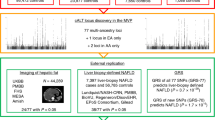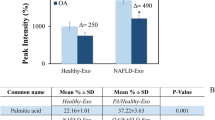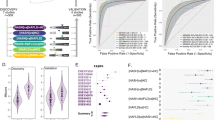Abstract
The genomic regions containing PNPLA3, SAMM50 and PARVB are susceptibility loci for the development and progression of nonalcoholic fatty liver disease (NAFLD). In order to search for all common variations in this region, we amplified the genomic DNA of 28 NAFLD patients by long-range PCR, covering the entire susceptibility region and sequenced the DNA using indexed multiplex next-generation sequencing. We found 329 variations, including four novel variations. Fine mapping of variations including insertion/deletions was performed for 540 NAFLD patients (488 with nonalcoholic steatohepatitis (NASH) and 52 with simple steatosis) and 1012 control subjects. HaploView analysis showed that linkage disequilibrium (LD) block 1 and 2 occurred in PNPLA3, block 3 in SAMM50 and block 4 in PARVB. Variations in LD blocks 1–4 were significantly associated with NAFLD as compared with control subjects (P<1 × 10−8). Variations in LD block 2 were significantly associated with the NAFLD activity score (NAS), aspartate aminotransferase and alanine aminotransferase. Variations in LD block 1 were significantly associated with the fibrosis stage. The strongest associations were observed for variations in LD block 4, with NASH as compared with simple steatosis (P=7.1 × 10−6) and NAS (P=3.4 × 10−6). Our results suggested that variations, including insertion/deletions, in PARVB, as well as those in PNPLA3, are important in the progression of NAFLD.
Similar content being viewed by others
Log in or create a free account to read this content
Gain free access to this article, as well as selected content from this journal and more on nature.com
or
References
Angulo, P Nonalcoholic fatty liver disease. New Engl. J. Med. 18, 1221–1231 (2002).
Farrell, GC Non-alcoholic steatohepatitis: what is it, and why is it important in the Asia-Pacific region? J. Gastroenterol. Hepatol. 18, 124–138 (2003).
Okanoue, T, Umemura, A, Yasui, K & Itoh, Y Nonalcoholic fatty liver disease and nonalcoholic steatohepatitis in Japan. J. Gastroenterol. Hepatol. Suppl 1, 153–162 (2011).
Ludwig, J, Viggiano, TR, McGill, DB & Oh, BJ Nonalcoholic steatohepatitis: Mayo Clinic experiences with a hitherto unnamed disease. Mayo Clin. Proc. 55, 434–438 (1980).
Wilfred de Alwis, NM & Day, CP Genes and nonalcoholic fatty liver disease. Curr. Diab. Rep. 8, 156–163 (2008).
Yoneda, M, Hotta, K, Nozaki, Y, Endo, H, Uchiyama, T, Mawatari, H et al. Association between PPARGC1A polymorphisms and the occurrence of nonalcoholic fatty liver disease (NAFLD). BMC Gastroenterol. 8, 27 (2008).
Yoneda, M, Hotta, K, Nozaki, Y, Endo, H, Uchiyama, T, Mawatari, H et al. Association between angiotensin II type 1 receptor polymorphisms and the occurrence of nonalcoholic fatty liver disease. Liver Int. 29, 1078–1085 (2009).
Yoneda, M, Hotta, K, Nozaki, Y, Endo, H, Tomeno, W, Watanabe, S et al. Influence of inducible nitric oxide synthase polymorphisms in Japanese patients with non-alcoholic fatty liver disease. Hepatol. Res. 39, 963–971 (2009).
Romeo, S, Kozlitina, J, Xing, C, Pertsemlidis, A, Cox, D, Pennacchio, LA et al. Genetic variation in PNPLA3 confers susceptibility to nonalcoholic fatty liver disease. Nat. Genet. 40, 1461–1465 (2008).
Chalasani, N, Guo, X, Loomba, R, Goodarzi, MO, Haritunians, T, Kwon, S et al. Genome-wide association study identifies variants associated with histologic features of nonalcoholic fatty liver disease. Gastroenterology 139, 1567–1576 (2010).
Speliotes, EK, Yerges-Armstrong, LM, Wu, J, Hernaez, R, Kim, LJ, Palmer, CD et al. Genome-wide association analysis identifies variants associated with nonalcoholic fatty liver disease that have distinct effects on metabolic traits. PLoS Genet. 7, e1001324 (2011).
Kawaguchi, T, Sumida, Y, Umemura, A, Matsuo, K, Takahashi, M, Takamura, T et al. Genetic polymorphisms of the human PNPLA3 gene are strongly associated with severity of non-alcoholic fatty liver disease in Japanese. PLoS One 7, e38322 (2012).
Hotta, K, Yoneda, M, Hyogo, H, Ochi, H, Mizusawa, S, Ueno, T et al. Association of the rs738409 polymorphism in PNPLA3 with liver damage and the development of nonalcoholic fatty liver disease. BMC Med. Genet. 11, 172 (2010).
Kitamoto, T, Kitamoto, A, Yoneda, M, Hyogo, H, Ochi, H, Nakamura, T et al. Genome-wide scan revealed that polymorphisms in the PNPLA3, SAMM50, and PARVB genes are associated with development and progression of nonalcoholic fatty liver disease in Japan. Hum. Genet. 132, 783–792 (2013).
Sanyal, AJ American Gastroenterological Association: AGA technical review on nonalcoholic fatty liver disease. Gastroenterology 123, 1705–1725 (2002).
Matteoni, CA, Younossi, ZM, Gramlich, T, Boparai, N, Liu, YC & McCullough, AJ Nonalcoholic fatty liver disease: a spectrum of clinical and pathological severity. Gastroenterology 116, 1413–1419 (1999).
Teli, MR, James, OF, Burt, AD, Bennett, MK & Day, CP The natural history of nonalcoholic fatty liver: a follow-up study. Hepatology 22, 1714–1719 (1995).
Brunt, EM Nonalcoholic steatohepatitis: definition and pathology. Semin. Liver Dis. 21, 3–16 (2001).
Kleiner, DE, Brunt, EM, Van Natta, M, Behling, C, Contos, MJ, Cummings, OW et al. Design and validation of a histological scoring system for nonalcoholic fatty liver disease. Hepatology 41, 1313–1321 (2005).
Li, H & Durbin, R Fast and accurate short read alignment with Burrows-Wheeler transform. Bioinformatics 25, 1754–1760 (2009).
Li, H, Handsaker, B, Wysoker, A, Fennell, T, Ruan, J, Homer, N et al. The sequence alignment/map (SAM) format and SAMtools. Bioinformatics 25, 2078–2079 (2009).
McKenna, A, Hanna, M, Banks, E, Sivachenko, A, Cibulskis, K, Kernytsky, A et al. The Genome Analysis Toolkit: a MapReduce framework for analyzing next-generation DNA sequencing data. Genome Res. 20, 1297–1303 (2010).
Wang, K, Li, M & Hakonarson, H ANNOVAR: functional annotation of genetic variants from high-throughput sequencing data. Nucleic Acids Res. 38, e164 (2010).
Robinson, JT, Thorvaldsdóttir, H, Winckler, W, Guttman, M, Lander, ES, Getz, G et al. Integrative genomics viewer. Nat. Biotechnol. 29, 24–26 (2011).
Thorvaldsdóttir, H, Robinson, JT & Mesirov, JP Integrative Genomics Viewer (IGV): high-performance genomics data visualization and exploration. Brief Bioinform. 14, 178–192 (2013).
Ohnishi, Y, Tanaka, T, Ozaki, K, Yamada, R, Suzuki, H & Nakamura, Y A high-throughput SNP typing system for genome-wide association studies. J. Hum. Genet. 46, 471–477 (2001).
Barrett, JC, Fry, B, Maller, J & Daly, MJ Haploview: analysis and visualization of LD and haplotype maps. Bioinformatics 21, 263–265 (2005).
Purcell, S, Neale, B, Todd-Brown, K, Thomas, L, Ferreira, MA, Bender, D et al. PLINK: a tool set for whole-genome association and population-based linkage analyses. Am. J. Hum. Genet. 81, 559–575 (2007).
Sookoian, S & Pirola, CJ Meta-analysis of the influence of I148M variant of patatin-like phospholipase domain containing 3 gene (PNPLA3) on the susceptibility and histological severity of nonalcoholic fatty liver disease. Hepatology 53, 1883–1894 (2011).
Zain, SM, Mohamed, R, Mahadeva, S, Cheah, PL, Rampal, S, Basu, RC et al. A multi-ethnic study of a PNPLA3 gene variant and its association with disease severity in non-alcoholic fatty liver disease. Hum. Genet. 131, 1145–1152 (2012).
Chen, W, Chang, B, Li, L & Chan, L Patatin-like phospholipase domain-containing 3/adiponutrin deficiency in mice is not associated with fatty liver disease. Hepatology 52, 1134–1142 (2010).
Basantani, MK, Sitnick, MT, Cai, L, Brenner, DS, Gardner, NP, Li, JZ et al. Pnpla3/Adiponutrin deficiency in mice does not contribute to fatty liver disease or metabolic syndrome. J. Lipid Res. 52, 318–329 (2011).
Li, JZ, Huang, Y, Karaman, R, Ivanova, PT, Brown, HA, Roddy, T et al. Chronic overexpression of PNPLA3I148M in mouse liver causes hepatic steatosis. J. Clin. Invest. 122, 4130–4144 (2012).
Kimura, M, Murakami, T, Kizaka-Kondoh, S, Itoh, M, Yamamoto, K, Hojo, Y et al. Functional molecular imaging of ILK-mediated Akt/PKB signaling cascades and the associated role of beta-parvin. J. Cell Sci. 123, 747–755 (2010).
Johnstone, CN, Mongroo, PS, Rich, AS, Schupp, M, Bowser, MJ, Delemos, AS et al. Parvin-beta inhibits breast cancer tumorigenicity and promotes CDK9-mediated peroxisome proliferator-activated receptor gamma 1 phosphorylation. Mol. Cell Biol. 28, 687–704 (2008).
Zhang, Y, Chen, K, Tu, Y & Wu, C Distinct roles of two structurally closely related focal adhesion proteins, alpha-parvins and beta-parvins, in regulation of cell morphology and survival. J. Biol. Chem. 279, 41695–41705 (2004).
Chakraborty, JB, Oakley, F & Walsh, MJ Mechanisms and biomarkers of apoptosis in liver disease and fibrosis. Int. J. Hepatol. 2012, 648915 (2012).
Fujii, H & Kawada, N Inflammation and fibrogenesis in steatohepatitis. J. Gastroenterol. 47, 215–225 (2012).
Acknowledgements
This work was supported by a Grant-in-Aid from the Ministry of Education, Science, Sports, and Culture of Japan (25461343 to KH, 23791027 to AK and 23701082 to TK).
Author information
Authors and Affiliations
Corresponding author
Additional information
Supplementary Information accompanies the paper on Journal of Human Genetics website
Rights and permissions
About this article
Cite this article
Kitamoto, T., Kitamoto, A., Yoneda, M. et al. Targeted next-generation sequencing and fine linkage disequilibrium mapping reveals association of PNPLA3 and PARVB with the severity of nonalcoholic fatty liver disease. J Hum Genet 59, 241–246 (2014). https://doi.org/10.1038/jhg.2014.17
Received:
Revised:
Accepted:
Published:
Issue date:
DOI: https://doi.org/10.1038/jhg.2014.17
Keywords
This article is cited by
-
Two differentially methylated region networks in nonalcoholic fatty liver disease, viral hepatitis, and hepatocellular carcinoma
BMC Gastroenterology (2022)
-
Identification of differentially methylated region (DMR) networks associated with progression of nonalcoholic fatty liver disease
Scientific Reports (2018)
-
Copy number variation in exportin-4 (XPO4) gene and its association with histological severity of non-alcoholic fatty liver disease
Scientific Reports (2015)



